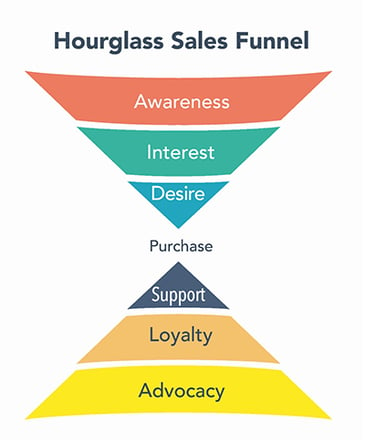Anyone familiar with sales or marketing will recognise the traditional model of the sales funnel. It can also be represented by the acronym AIDA: Awareness, Interest, Desire, Action.
As a model, it was developed in 1898 by American advertising advocate E. St. Elmo Lewis- in the days before the Internet, before television and even before radio.
One of my favourite quotes is from a contemporary of Elmo Lewis, Charles Kettering (1876-1958), a prolific American inventor and businessman with 186 patents to his name:
"If you're doing something the same way you have been doing it for ten years, the chances are you are doing it wrong."
Given that the AIDA concept is now over one hundred and twenty years old, it's hardly surprising that it might benefit from a bit of re-thinking.
In B2B marketing, the Funnel was traditionally "fed" with leads from networking and referrals from clients. While some business is still generated using this approach, the way companies make sales has changed drastically over the years, to the extent that several marketing pundits have even suggested that the entire concept of the sales funnel might be obsolete.
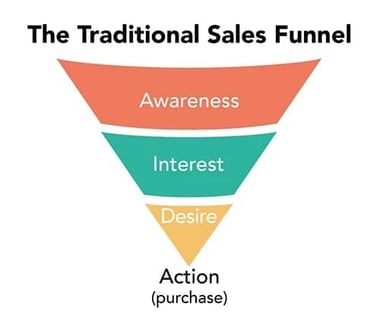
We know that the way a potential client looks for a product or service has radically changed since the model was proposed.
In the old model, a prospect would respond to an advert, a piece of direct mail, a sales call, or maybe talk to a salesperson at a networking event, business exhibition or conference. The salesperson would then handle the whole process, guiding the customer down through the Funnel, culminating, hopefully, in a sale. Contacts became leads; leads became prospects, and prospects became clients.
But now, potential buyers are doing something entirely different. They are researching their issues and possible solutions online; they are working out what they need based on online guides, educational material and helpful blog posts. Gartner research shows that customers are three times more likely to buy a bigger deal with less regret when suppliers provide useful information during the purchase process. [1]
They are turning to social media and review networks for recommendations and feedback, with 75% using social networks to learn about different vendors, [2] and 45% of buyers using reviews during their purchase process.
These reviews get shared within their social networks – 92% of buyers who use reviews share them with at least one other person, 40% share B2B tech reviews with four or more other buying committee members, and 12% share them with more than ten people. [3] 71% share business-related content on LinkedIn, 43% on Twitter and 43% on Facebook and 40% on internal social platforms. [4]
They are investigating potential suppliers' websites and making a shortlist before even talking to you – 87% of buyers want to self-serve part or all of their buying journey. Perhaps even more revealing is that 57% of buyers already make purchase decisions without ever talking with a vendor representative. [3]
When they pick up the phone, they know what they want, have specific questions they need answering and are ready to talk business.
This means that prospects are entering the Funnel at different stages and via a wide variety of channels. For example, the average B2B tech buyer today consults 6.9 information sources before making a purchase. [3]
Some are still following the traditional route from the top down. But most are engaging later in the process or even at the very last stage of the Funnel.
Sales and Marketing are handling the stages of the Funnel differently, too. Originally Marketing would just be involved in the awareness stage and potentially some of the interest stages too, with Sales handling everything else. Today, Marketing is responsible for most of the Funnel with Sales only involved at the end during purchase.
B2B buyers are also rejecting old school sales techniques; in a survey, the top three marketing tactics that buyers hate are:
- too many marketing emails,
- cold calling and
- aggressive sales representatives. [3]
In a recent report by LinkedIn, too many emails and cold calling was seen as an immediate deal-killer by 34% of buyers. [5]
Sales Funnel vs Customer Journey
It's probably worth taking a minute to talk about the differences between the Sales Funnel and the Customer Journey, as these can seem, on the surface, to be different phrases for the same thing.
Your Sales Funnel is a high-level, theoretical model of how you would like your customers to be 'funnelled' into a purchase. You would like them to go from Awareness to Interest to Desire and Action. Some customers will drop into the top of the Funnel, but others will enter further down. It is a relatively simple model for talking about the marketing process.
On the other hand, A Customer Journey is an actual journey a customer takes to a purchase – which is rarely a straight line. Some customers may become interested and then move on to something else, only to return later.
95% of buying groups have to re-visit earlier parts of the journey as new information becomes available. [2] Purchase decisions may get delayed due to circumstances. Customer requirements may change halfway through the process. And as we've already mentioned – different customers will engage with you at other points in the sale funnel. So a customer's journey will vary from customer to customer. It is often a complex and circuitous route.
Recent research shows that the average number of buyer interactions during the pandemic jumped from 17 to 27. [6]
Trying to work out how you arrived at a sale by tracking every step in a customer journey is one of the toughest challenges a marketing department faces.
To confuse matters, it is also essential to think about the theoretical Customer Journey – the 'typical' Customer Journey – as this will help you plan your marketing and content. The more you can understand the paths that customers take to arrive at the purchase decision, the more you will do to smooth the way. It is crucial as 64% of buyers say that vendors do not approach them at the right time. [7]
Essentially, you aim to create marketing content and interactions that will steer the customer journey, so it follows your sales funnel model as closely and as quickly as possible.
Death of the Sales Funnel
If you believe in the death of the sales funnel, and think it's all very unstructured now, then you might visualise it as a sort of a squiggly mess of circles and lines as featured in PK's infographic.
Like all models, you have to decide whether they ring true in your experience and whether they work for you. I don't find this model either representative of the current situation or, more importantly, a helpful way of thinking about things.
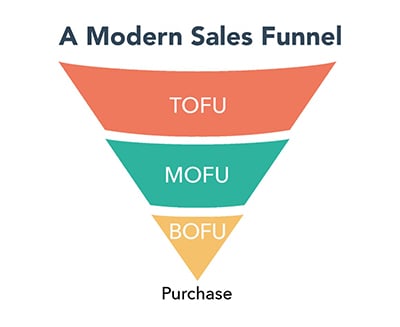 TOFU, MOFU and BOFU - a modern take on the Funnel
TOFU, MOFU and BOFU - a modern take on the Funnel
A more recent way of looking at the sales funnel reflects the current situation for many. It involves splitting the Funnel into three parts: Top of Funnel (TOFU), Middle of Funnel (MOFU) and Bottom of Funnel (BOFU).
- TOFU - providing educational content, answering questions, responding to problems.
- MOFU - focusing on defining your services, allowing prospects to compare solutions.
- BOFU - offering opportunities to sample/trial your solution, working towards a sale.
This has several implications for both the Funnel and the sales team. The salesperson is effectively side-stepped in the middle stages of the Funnel - so this now extends the domain of the marketer - with the availability, usefulness and effectiveness of a company's online content being the deciding factor in whether the company attracts new leads or not.
However, this doesn't decrease the value of the sales team - it just means they have a different focus and need to work more closely with marketing.
Further challenges to the model arise from the increasing trend for collaborative buying decisions; 63% of purchases have more than four people involved. [6] This implies that the buying decision is complicated, with no one person being led through the Funnel.
Going beyond the sale with the hourglass model
A few years back, Jeremiah Owyang presented a Marketing Hourglass that mirrors the Funnel around the purchase, with the bottom half including support, loyalty and advocacy. These additional steps make sense - if you support your clients well, they are likely to become loyal, repurchase, and eventually act as advocates for your business - providing referrals and effectively selling on your behalf. Business networks, such as LinkedIn and other forms of social media offer a platform for these "digital" referrals.
Supporting your clients is also vital for prospects in the research stage, who are likely to pick up on negative feedback and complaints by unhappy clients on social media and in peer-to-peer networks.
Whereas Customer Service is not a factor in the traditional model, here, in the hourglass model, it is equally crucial to its success as Sales or Marketing.
Buyers are on average 34% more likely to buy and 32% more likely to renew a contract with B2B suppliers that master customer experience. [2]
But perhaps an hourglass is not quite the right shape as it implies a large number of advocates from a small number of sales?
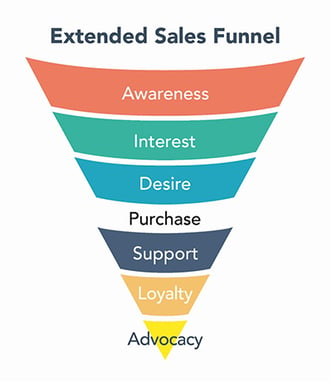 So maybe… it's better to stick with the funnel concept and extend it so that the bottom of the Funnel becomes longer. Somehow this doesn't seem to represent the true power of the post-sales and returning sales process.
So maybe… it's better to stick with the funnel concept and extend it so that the bottom of the Funnel becomes longer. Somehow this doesn't seem to represent the true power of the post-sales and returning sales process.
The HubSpot Flywheel Model
The great thing about the Flywheel Model used by HubSpot is that it captures the dynamism and the energy of the process in a way that the Funnel does not. A traditional funnel suggests that prospects enter the top of the Funnel, and customers fall out of the bottom. And that is pretty much the end of things. Those customers aren't considered to be important once you've made the sale.
But we've already considered that those customers can make repeat purchases. They can become fans of the business and therefore brand ambassadors – promoting your business to their peers, thus creating more prospects, leading to more sales and more customers, who in turn talk to their peers, and so on. This is the flywheel concept; as it spins, it generates more energy, leading to more success.
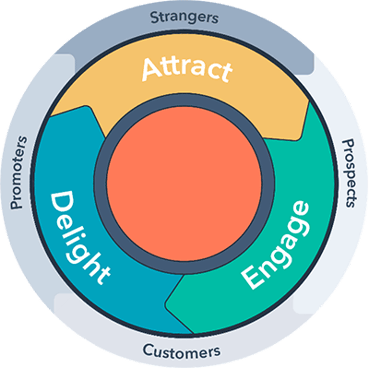 According to HubSpot:
According to HubSpot:
"With the flywheel, you use the momentum of your happy customers to drive referrals and repeat sales. Basically, your business keeps spinning".
Three factors determine how much energy your flywheel contains:
- How fast you spin it
- How much friction there is
- How big the flywheel is
The speed comes from the effort you put in – your marketing. The more focused, effective your marketing is, and the more you do, the faster the spin.
But it's not plain sailing; you need to remove any friction – any issues which might reduce the momentum. Whether that be a lack of alignment between Sales and Marketing, slow response times to queries, poor brand positioning or confusing messages – anything that might reduce the delivery of your marketing plan should be smoothed out or removed.
The flywheel size depends on the number of people involved – how many customers do you have singing your praises? How many industry influencers or peers are on your side? How many of your salespeople, marketers, customer service personnel and so on are working towards the business's success through positive customer interactions.
And this is perhaps the most substantial benefit of the flywheel, its ability to focus the minds of all employees within a company, whether from sales, marketing, customer support or elsewhere, on the idea of keeping the wheel spinning the success going and building momentum.
With the flywheel, everyone aligns with attracting, engaging, and delighting customers and working to eliminate anything that gets in the way of that process.
Ten actions addressing the common issue
Whichever model you want to run with, they are all trying to represent how the buyer's journey has radically changed.
This change means your marketing approach has to adapt. Here are ten key actions:
- Create informative, educative content – blog posts, videos, podcasts – so you get found in searches by people looking for what you do.
- Ensure your website is comprehensive, up to date and mobile-friendly.
- Offer downloadable eBooks, white papers and other helpful content.
- Create landing pages with calls-to-action to convert website visitors into leads.
- Become active in business social media – engaging and helping (not selling).
- Create case studies, spec sheets and presentations for clients close to buying.
- Ensure personnel with responsibility for marketing and sales work together.
- Track the client's journey using inbound software systems.
- Use this information to undertake lead nurturing, scoring and segmentation.
- Support existing customers, turning them into not just repeat customers but into advocates.
To quote Charles Kennedy again: "The world hates change, yet it is the only thing that has brought progress." All the revisions of Mr Lewis' long-standing model acknowledge that the online world has changed the sales funnel forever. Professional services companies must recognise that and amend their marketing strategy accordingly.
References:
[1] Gartner 2021
[2] Deloitte 2021
[3] Trust Radius 2021
[4] DemandGen 2021
[5] LinkedIn 2021
[6] Forrester 2021
[7] Durhamlane 2021

